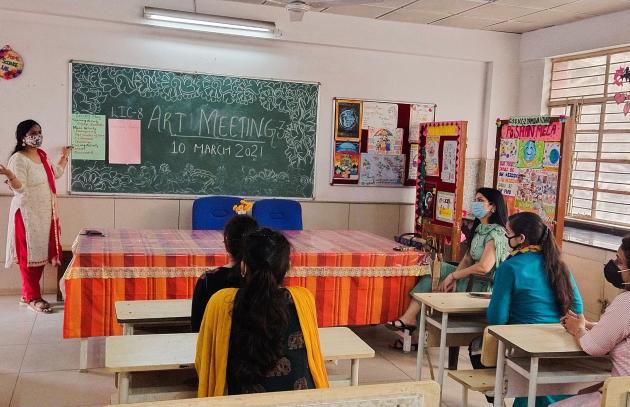head_of_the_school_-_himlesh_singh_teacher_development_coordinator_mrs._deepa.jpg

Teachers are often said to be the heart of education. But, when it comes to improving teacher practices and learning outcomes, planners and policy-makers increasingly look at roles at a different level in the education system – those positioned at the middle tier.
These are the professionals working between the school and the central level – and they can play a valuable role in changing how things happen in the classroom. But not, just one classroom, but across a whole education system. This is because the middle tier leader acts as a unique link between policy-making and teachers, contributing to a whole learning system that is built on collaboration and trust.
More specifically, middle tier leaders – who often fill district or regional roles or work across schools – can share knowledge on best practices, scale up innovations in the classroom, and provide much needed instructional direction to school-level practitioners. They also understand the real issues many teachers face and with their access to the central level, they can go beyond supporting individual classrooms or schools to drive whole system transformation.
Global policy reforms have historically embraced a more top-down approach, focusing more on the school level as the place where national reforms ultimately play out. However, education systems today can no longer afford to overlook the middle tier as they seek to reconceptualize professional development and support teachers for improved learning.
Through our research with Education Development Trust, here are five reasons why education policy-makers should invest more in the middle tier.
1. The middle tier can increase motivation and professionalism
Many different elements contribute to a teachers’ effectiveness. However, one area that is not looked at enough is the level of professional support teachers receive and how they collaborate with each other. The middle tier can spearhead initiatives that directly engage with head teachers and teachers, helping to foster greater collaboration in schools. This can shift the overall culture in a positive manner by improving motivation and allowing teachers to feel more comfortable to try new strategies or teaching methods.
“Before I used to work alone, I was not that collaborative but now I value to collaborate with others.”
- Local Leader of Learning, Rwanda

2. The middle tier can cultivate a learning system
In recent decades, many public sector reforms have focused on technical solutions and tight management control. Yet, successful reforms are often associated with shifting day-to-day professional practices, something that the middle tier can provide invaluable support with. Well-designed instructional leadership roles at this level can ensure powerful professional development for school-based professionals. This approach carves out spaces of empowerment where issues can be solved collectively, and it builds capacity to deal with them over time.
“Before, we were just grumbling over the things saying this is not happening, that is not happening, [there is] this problem and that problem. Now we are putting our heads together to see how we can solve it."
-Teacher Development Co-ordinator, Delhi
3. The middle tier has a multiplier effect and does not require complex system changes
As the middle tier level already exists - and is budgeted for - in nearly all countries, strengthening this level of the system also does not require considerable system change. Rather, it may simply involve a refocusing of a position’s role or trying to find a better balance between support and accountability to make a strong impact on a system’s culture and professionalism. Instructional leaders at the middle tier, who are working with a large number of teachers and schools have a multiplier effect. Strengthening middle tier roles offers great potential for improving teaching and learning outcomes in a cost-effective manner.
4. The middle tier can balance out accountability measures
Alignment and direction provided by the middle tier around a shared sense of purpose can help to off-set a tendency to overly focus on accountability. Accountability routines that are excessively compliance-oriented can hinder the professionalism of teachers and school leaders. Instructional leaders at the middle tier can help to offset this over-reliance on accountability and reset priorities around learning by giving more agency to teachers for greater collaborative problem-solving and opportunities for professional growth.
“We are solution builders, not decision-makers.”
-System leader, Wales
5. The middle tier can help bridge the gap between theory and practice
Middle tier leaders can make sure that the grassroots experiences and voices are heard by policy-makers. As the voice of the teaching profession, they can translate policy into meaningful steps of what needs to happen at the school level and can ensure that teacher and head teacher feedback is taken seriously. In this sense, the middle tier is the glue that holds the system together as it orients it towards collaboration, learning, and opportunities for professional growth for some of its most valuable members – its teachers.
“The middle-tier space plays a significant role in the transfer of government policy into practice in schools. Middle-tier leaders are the translators and interpreters of policies, and advisers and supporters to schools and teachers.”
-Official from Shanghai







